

~ Tutoriel tissage aux cartes par Vigdis ~ - L'atelier viking de Vigdis. Suite à la demande de plusieurs personnes en animation, j'ai décidé de réaliser mon propre tutoriel en le combinant avec différents liens qui m'ont été très utiles au début.
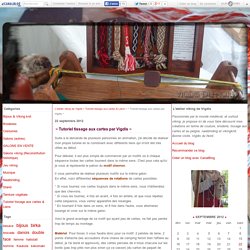
Pour débuter, il est plus simple de commencer par un motifs où à chaque séquence toutes les cartes tournent dans le même sens. C'est pour cela qu'ici je vous ai représenté le patron du motif chevron. Il vous permettra de réaliser plusieurs motifs sur le même galon. En effet, voici différentes séquences de rotations de cartes possibles: ° Si vous tournez vos cartes toujours dans le même sens, vous n'obtiendrez que des chevrons.° Si vous les tournez, 4 fois en avant, 4 fois en arrière, et que vous répétez cette séquence, vous verrez apparaître des losanges. ° En tournant 8 fois dans un sens, et 8 fois dans l'autre, vous alternerez losange et croix sur le même galon. Voici le grand avantage de ce motif qui ayant peu de cartes, ne fait pas perdre trop de temps au montage.
Bon tissage ! Vigdis du Nord. Backstrap Weaving. Laverne, ¿Hablas español?
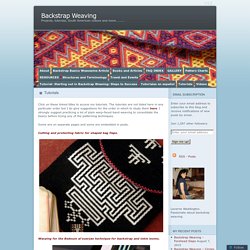
Estoy estudiando tu libro de tejido de doble faz y practicando paso a paso, como me sugeriste (intenté tejer una banda más ancha en telar de cintura, pero tuve problemas porque la urdiembre me quedó con tensión dispareja y se fue soltando en algunas partes; reintentaré con la urdiembre repetidamente, para volver al de cintura pronto, por ahora estoy con un telar rígido). Quería preguntarte cómo logras que el comienzo del tejido te quede parejo. Estoy tejiendo una banda de 8 revoluciones (la primera del libro), y si bien he logrado hacer el diseño, el comienzo del tejido se tendió a enrollar. ¿Esto resulta mejor si al urdir se deja las hebras en el orden definitivo, como enseñas en el anexo? From pattern to woven band – step by step. Reading a pattern The column numbers at the top are the tablet numbers, the letters down the left had side are the holes in each tablet, the bottom row indicates whether each tablet is S or Z threaded and the list over on the right indicates how many warp threads are needed in each colour.
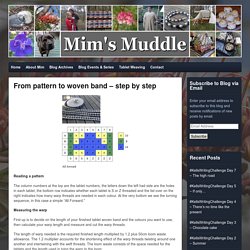
At the very bottom we see the turning sequence, in this case a simple “All Forward.” Measuring the warp First up is to decide on the length of your finished tablet woven band and the colours you want to use, then calculate your warp length and measure and cut the warp threads. The length of warp needed is the required finished length multiplied by 1.2 plus 50cm loom waste allowance. Warp length = (finished length x 1.2) + 50cm. Tablet Weaving. Tablet weaving is often called card weaving in the US, but "tablet weaving" has a wider acceptance.
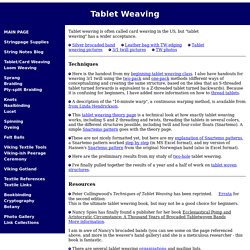
Silver brocaded band Leather bag with TW edging Tablet weaving pictures 3/1 twill pictures TW photos Techniques Here is the handout from my beginning tablet weaving class. A description of the "10-minute warp", a continuous warping method, is available from from Linda Hendrickson. This tablet weaving theory page is a technical look at how exactly tablet weaving works, including S and Z threading and twists, threading the tablets in several colors, and the different structures possible, including twill and four-color floats (Snartemo).
These are not nicely formatted yet, but here are my explanation of Snartemo patterns, a Snartemo pattern worked step by step (in MS Excel format), and my version of Hansen's Snartemo pattern from the original Norwegian band (also in Excel format). The Loomy Bin - Card Weavers' Pattern Library. The Ancient Craft of Tablet Weaving: Getting Started. This document is provided as is without any express or implied warranties.
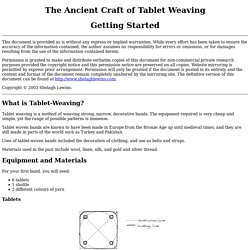
While every effort has been taken to ensure the accuracy of the information contained, the author assumes no responsibility for errors or omissions, or for damages resulting from the use of the information contained herein. Permission is granted to make and distribute verbatim copies of this document for non-commercial private research purposes provided the copyright notice and this permission notice are preserved on all copies. Website mirroring is permitted by express prior arrangement. Permission will only be granted if the document is posted in its entirety and the content and format of the document remain completely unaltered by the mirroring site.
The definitive version of this document can be found at Copyright © 2003 Shelagh Lewins. What is Tablet-Weaving? Tablet weaving is a method of weaving strong, narrow, decorative bands. Materials used in the past include wool, linen, silk, and gold and silver thread. Tablet Weaving Notes. Your Cards I've decided that my ideal tablet weaving cards are actually playing cards.
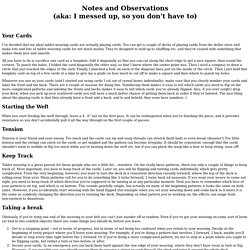
You can get a couple of decks of playing cards from the dollar store and make lots and lots of tablet weaving cards for not much money. They're designed to hold up to shuffling etc, and they're coated with something that makes them nice and smooth. All you have to do is sacrifice one card as a template, fold it diagonally so that you can cut along the short edge to get a nice square, then round the corners.
To punch the holes, I folded the card diagonally the other way, so that I knew where the center point was. Whatever you use as your cards (and I started out using cards I cut out of cereal boxes individually), make sure that you clearly number your cards and label the front and the back. Beginning Tablet Weaving. Warp - the threads which run in a vertical direction.
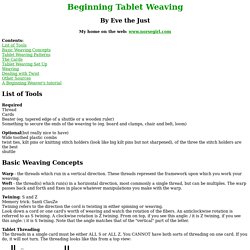
These threads represent the framework upon which you work your weaving.Weft - the thread(s) which run(s) in a horizontal direction, most commonly a single thread, but can be multiples. The warp passes back and forth and fixes in place whatever manipulations you make with the warp. Twining: S and Z Memory trick: Santi ClauZe Twining refers to the direction the cord is twisting in either spinning or weaving. Look down a cord or one card's worth of weaving and watch the rotation of the fibers.
An anticlockwise rotation is referred to as S twining. Tablet Threading The threads in a single card must be either ALL S or ALL Z. When S threaded cards are turned forward they produce a Z twined cord, when turned in reverse, they produce an S twined cord. A Shed is a term for the space between two layers of warp threads through which your shuttle and thus your weft thread will pass.